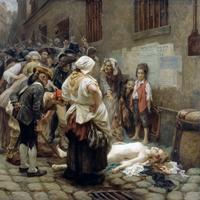More about Léon Maxime Faivre
Works by Léon Maxime Faivre

Contributor
Leon-Maxime Faivre was a Parisian man through and through, but his paintings show a scope far beyond his hometown.
Like many Parisian artists, he joined a ‘societe,’ which were basically frats for male painters back in the day. Under the guidance and tutelage of Jean-Léon Gérôme, he pledged the Société des Artistes Français who soon began presenting his work in their annual Salons.
Faivre explored a wide range of painting genres: allegorical, portraits, historical scenes, landscapes, and still life. His most famous paintings, such as Death of Princess Lamballe, and Two Mothers, depict humanity in its most vulnerable state and pique the viewer’s interest by alluding to a larger story. His paintings also express a keen interest in history and anthropology. He even made a series of paintings re-imagining the life of early man, depicting the strife most likely faced by cavemen. His most well-known paintings from this series display scenes that emphasize the hardships faced by early man, such as a primitive woman frantically pulling her children away from some obscured danger, a family hiding while hunting a bear, and two men locked in a fight to the death in front of a concerned woman and child.
Beyond the remarkable work he left behind, not much else is known about Faivre’s life as it remained mostly undocumented.
Sources
- http://www.mheu.org/en/timeline/death-princess-lamballe.htm
- Benezit Dictionary of Artists ISBN: 9780199773787










